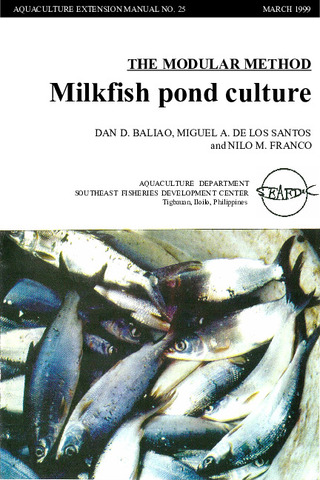Effect of dietary fatty acids on growth of milkfish Chanos chanos fry in brackish water
- Global styles
- MLA
- Vancouver
- Elsevier - Harvard
- APA
- Help

View/
Date
1996Page views
3,559ASFA keyword
AGROVOC keyword
Taxonomic term
Metadata
Show full item record
Share
Abstract
Five purified microbound diets containing 1% of 18:2n − 6, 18:3n − 3, 20:4n − 6, or n − 3 highly unsaturated fatty acids (HUFA: 60% 20:5n − 3 + 40% 22:6n − 3) in addition to 8% 18:1n − 9, and a control diet containing 9% 18:1n − 9 were fed to milkfish fry or late postlarvae for 30 days (Trial 1) and 35 days (Trial 2). The salinity was 16–17‰ and temperature was 27 ± 1 °C during the culture periods. A completely randomized design with three replicates per treatment per trial was followed. In each trial, 60 fish (5mg, 6mm) were stocked per 301 oval plastic tank and fed the experimental diets at 20% of biomass per day.
Survival of 100% observed for all groups in both trials demonstrated that the milkfish fry reared in brackish water utilized the test diets. Specific growth rates did not differ significantly among treatments (P 0.05), with values of 9.5–9.9% and 10.0–10.3% in Trials 1 and 2, respectively. Weight, length and feed conversion ratio of milkfish fry fed the various diets also did not differ significantly (P 0.05). Although not significantly differentiated in Trial 1 (P 0.05), incidence of eye abnormality was highest in milkfish fry fed the 18:1n − 9 diet in Trial 2 (P 0.05).
Suggested Citation
Alava, V. R., & Kanazawa, A. (1996). Effect of dietary fatty acids on growth of milkfish Chanos chanos fry in brackish water. Aquaculture , 144(4), 363-369. https://doi.org/10.1016/0044-8486(96)01304-X
Type
ArticleISSN
0044-8486Collections
- Journal Articles [1258]
Related items
Showing items related by title, author, creator and subject.
-
Series: Aquaculture extension manual; No. 25
The modular method: Milkfish pond culture
Baliao, Dan D.; de los Santos, Miguel A.; Franco, Nilo M. (Aquaculture Department, Southeast Asian Fisheries Development Center, 1999)The modular method of milkfish culture (Chanos chanos) described in the manual is an improvement over the traditional extensive method. The manual is intended for the use of fish farmers and aquaculturists, extensionists, ... -
Evaluation of organic and inorganic fertilizers in brackishwater milkfish ponds
Bombeo-Tuburan, Isidra; Agbayani, Renato F.; Subosa, Precilla F. (Elsevier, 1989)The study was conducted in twelve 144-m2 ponds to evaluate the effect of different organic and inorganic fertilizers on the growth, survival, gross production, and profitability of marketable milkfish. The ... -
Milkfish breeding and hatchery technology at SEAFDEC/AQD
Unknown author (Aquaculture Department, Southeast Asian Fisheries Development Center, 1999)Describes the techniques already adopted by the private sector: broodstock management, broodstock diet, commercial fry production, live transport, and larval diet. A list of AQD research publications on milkfish is included.





